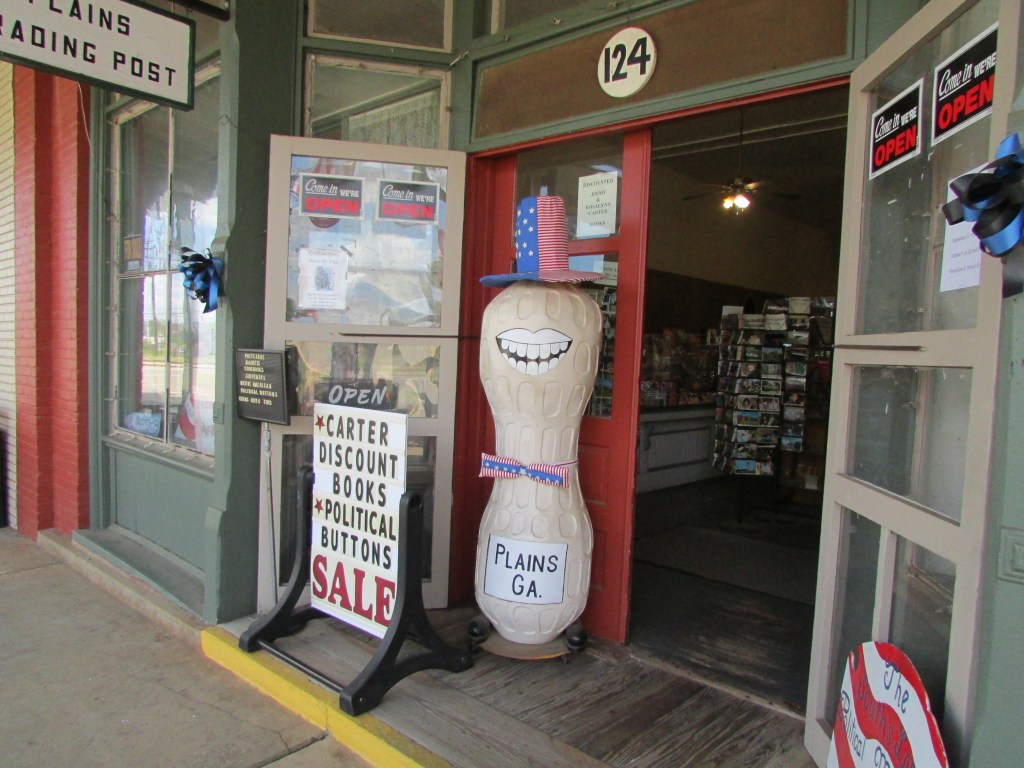Life is Better with Peanuts
Published 2:33 pm Sunday, November 12, 2023
|
Getting your Trinity Audio player ready...
|
I love it when fall comes and while driving on down the road I see a heard of John Deere tractors “plowing” over the rows, wrapping up the vines that the peanuts grew on, so they can be shipped and turned into food for animals. I can see cows, horses and piggys loving a peanut vine sandwich!
Therefore today, we will talk about our farmers and Decatur County’s agricultural past. When you think about it, every time you are enjoying a peanut butter sandwich, you have our farmers to thank because over 50% of the nation’s peanuts come from Georgia. So today, we are going to find us a nice shady spot, bring out our peanut butter sandwiches, some sweet tea, and enjoy a picnic, as we talk about the history of the peanut in Decatur County.
It was South American farmers who are believed to have started growing peanuts more than 3500 years ago. At first, they gathered wild peanuts and then later, they grew their own from seed. As tribes shared this way of life, the peanut spread across South America. It is known that in around 900 BC these tribes ground peanuts into paste and mixed it with cocoa. Peanut butter and chocolate! Sounds good!
Trending
The Inca Indians worked together on community farms and used llamas to transport their peanut crop. During the dry season and droughts, they brought water to their fields by digging ditches that drained water from lakes and streams. Also, because jars filled with peanuts were found in the graves of the ancient Incas, we know that they also used them to provide food in the afterlife for their loved ones.
The Ancon Indians, who lived on the coast of Peru from 500 to 750 BC, also buried their ancestors with peanuts and other food, so they, too, would not be hungry after they passed. The Moche Indians, who also lived in Peru from 200 BC to 800 AD, decorated their pottery with shells from peanuts.-
Among many Brazilian Indian tribes, the women planted and harvested peanuts. It was believed that if men cared for the peanut plants, they would not yield any peanuts. Eventually, these South American Indians traded peanuts with the tribes of Central America, Mexico and the Caribbean Islands, where they were called, “mani”. They would plant the peanut seeds in their gardens.
However, the spreading of the peanut was just beginning. The South American Indians began trading peanuts, with the Europeans for other supplies. They also showed them how to grow the plants.
We are now in the 1500s, when the Spanish explorers conquered the Incas and Portuguese explorers and defeated many of the Brazilian tribes. After these conquests, the explorers shipped peanuts to Europe, Asia and Africa. Also, in 1511, the Mayans in Mexico, captured some explorers and while in prison, fed them peanuts.
Also in the 1500s, the Aztecs in Mexico used many parts of the peanut plant in medicine. For instance, they soothed aching gums with a peanut paste.
Trending
Around the 1700s, African tribes in Haiti and Nigeria, mashed peanuts until they were thick and sticky. This was their peanut butter which they ate by itself or with rice.
How the peanut arrived in the United States for sure, is still not known. However, the African tribes who arrived here are credited with developing the peanut. They called them “nguba”, the Kimbundu word for peanut. In the late 1700s and early 1800s, they planted the peanuts in their personal gardens. The African tribes also believed that peanuts had souls and would cast them in bronze and gold.
With all of these uses of peanuts that go beyond tasting good, the farmers became inspired and began to grow fields of peanuts. They found that this versatile crop was well suited for Georgia’s environment. Peanuts need warm weather, sunshine and no risk of frost. They grew best in sandy soil with a fair amount of rain. Georgia has all of this!
On these first plantations, farmers grew peanuts to feed chickens, turkeys and pigs. They also crushed the peanuts into oil and made soap to trade with Europe.
In these early days, only a few folks liked peanuts. That changed during the War Between the States, when soldiers from the South and North ate peanuts, which were then known as “goober peas”. Peanuts became a popular food with the troops because they could be easily transported in a pouch or a backpack. When in camp, the troupes could roast them on a campfire or boil them in water. When on the move, soldiers ate peanuts raw. Near the end of the War, when food was scarce in the South, many soldiers ate nothing but peanuts.
Many Northern soldiers saw peanuts for the first time when they marched past peanut fields in Virginia. Also, peanut oil was used by Southern railroad engineers to lubricate their locomotives and Southern women cooked with the oil, instead of lard or butter.
In 1890, a St. Louis doctor fed whipped peanut butter to his elderly patients because it contained as much protein as meat, yet was easier to digest.
In the early 1900s, the main crop of the South was cotton but the land was getting weak from growing too much cotton. This, coupled with devastating effects of the infestation of the boll weevil, which nearly destroyed the cotton crops, peanuts became an important cash crop for our farmers.
The person who is given the most credit for helping the agricultural industry come back from the damage brought on by the boll weevil was Professor George Washington Carver, a leading researcher at the Tuskegee Institute. During his fifty years of experimenting with the peanut, he discovered over 300 ways to use this crop. He became known for his brilliant ideas and energetic personality. Carver helped make the peanut one of Americas most popular crops. He even talked to Congress about the uses of the peanut.
Carver was born in 1864, near Diamond, Missouri. As a small child he loved to nurse weak plants back to good health. When he was about 12 years old, he felt he needed to learn more about his passion and left home to get an education.
While studying agriculture at Iowa State College, he expanded his love for plants by studying art. In 1893, one of his flower paintings won honorable mention at the World’s Fair. Then in 1894, he graduated from Iowa State College and in 1896, he became the director of the Agricultural Department at the Tuskegee Institute. His main goal became helping the Southern farmer by discovering that peanut plants restore nitrogen to the soil and that they would grow where other crops no longer would. With the soil coming back to life, the farmers began growing more peanuts and cut back for a while on cotton. Thus, peanuts helped the South rebuild its agricultural economy. In 1943, at the height of World War II, the United States Army fed its soldiers 57 million pounds of peanut butter.
Later, in 1968-1972, during the Apollo space flights, dry ¾” peanut butter sandwiches were sent into space, when an astronaut chewed the mini sandwich, his saliva added moisture to it.
Another person who helped promote Georgia peanuts was James (Jimmy) Carter, who in January of 1977, became the 39th President of the United States. He was of a family which for generations were farmers and mostly grew peanuts in his hometown of Plains, Georgia. His Georgia friends who supported him when he ran for president, were nicknamed the “peanut brigade”.
There is a lot of work involved in growing peanuts, with about two billion pounds grown in Georgia every year. However, Georgia farmers are happy to keep up the supply. Our peanuts contain more protein than eggs, beef or fish plus they are delicious. They also are an excellent source of B vitamins, vitamin E, zinc, magnesium, potassium and phosphorus.
At first peanuts were grown to feed the hogs. However, when it was discovered how they could be processed and used in cooking and that they taste delicious, there was no looking back. Today, it is a valued food and oil crop in America. The entire peanut plant is used in many ways.
Not only can you roast or boil peanuts, you can salt them, or cover them with chocolate. Peanuts can be mixed into or put on top of ice cream. You can mix them into caramel to make peanut brittle, and add them to cookies.
Tasty, nutritious and packed with antioxidants, peanut butter can also serve as a healthy butter alternative. If you like the taste, simply substitute smooth peanut butter for the butter in recipes for baked goods. You can blend it into milk or even make a salad dressing or other sauces.
There are other ways to use peanut butter around the house, too. For instance, if you have trouble getting your dog to take its medicine, you can entice your furry friend to swallow a pill by sticking it into the center of a little glob of peanut butter.
Peanut butter can also be used to lure winter birds to your yard. Hang pinecones stuffed with a mixture of peanut butter and coarse cornmeal as a treat for them. It is so much fun to watch them eat this treat from the pine cones.
Peanut oil can also help in doing different things around the house. Many chefs prefer to cook with peanut oil because it can be heated to a higher temperature than most oils and it doesn’t absorb odors.
You can rub a bit of peanut oil on a door hinge to lubricate it and stop it from squeaking. Or put some on a cotton cloth to polish leather and vinyl and also buff up wooden items. The oil from the peanut is also used in paints and lamp oil. You can smear the oil on garden tools, including wooden handles, as a winter preservative and apply it to lawn mower blades as a lubricant.
Out on the farm, the stems and leaves from the peanut plant can be mixed into food for livestock as this plant is full in high protein. They can also be used as hay for live-stock or even fertilizer because when roots are plowed under, they enrich the soil.
There are also industrial uses for peanuts and their plants. It is used in explosives, textile fibers, and lubricating machinery. While the ground up shells are put into plastics and wood substitutes, fire logs, cat litter and wall board. Even the skin of the peanut has use in paper.
No story about peanuts would be complete without a recipe for genuine boiled peanuts. However, there is no firm method for cooking boiled peanuts. To boil up a fresh batch requires three basic ingredients: raw peanuts, water and a load of salt. Best results come when you use green peanuts which are those that are pulled before they reach maturity which is in late summer or early fall.
Wash peanuts thoroughly in cool water, then soak in clean, cool water for about 30 minutes before cooking. Put peanuts in saucepan and cover completely with water. Start with one cup of salt per two gallons of water. The shells of some peanuts absorb more salt than others. So, it is best to begin salt as prescribed then taste as you go.
Cooking time for boiled peanuts varies according to the variety and maturity of the peanuts used. Cooking time for freshly pulled, green peanuts is shorter than for peanuts which have been stored for a time. The best way to prepare peanuts is to cook them as soon as they are picked.
Boil the peanuts for about 35 minutes then taste. If they are not salted enough, add more salt and taste again in 10 minutes, both for salt content and to see if the peanuts are fully cooked. They should be soft. If they are crunchy, cook them longer and continue tasting every 5 minutes until they have a satisfactory texture. Drain peanuts after cooking or they will continue to absorb salt and become oversalted.
To have boiled peanuts year-round freeze them. Package the bolled peanuts without the brine in freezer safe containers. When ready to eat, remove from freezer and thaw.
Many towns pay tribute to the peanut by building monuments to them. The largest one in Georgia is in Plains, on Route 45. This peanut statue is 14 feet tall and has an interesting history. When Georgia’s former governor and peanut farmer, Jimmy Carter, was running for president in 1976, three Indiana residents created a giant, styrofoam peanut. It was made from wooden hoops, covered with chicken wire, polyurethane and aluminum foil. They used it in a parade honoring Carter. After the parade, the peanut was transported to Plains, Carter’s home town. For years, it was on the steps of the train depot that had served as his campaign headquarters.
Souvenir hunters gouged out pieces of it and carved their names into it. Not in very good shape, the owners of Davis EZ Shop, filled the bottom with concrete to make it sturdier and anchored it in front of their store. It became the most photographed peanut in Georgia. Now, it needed more space and was moved to Route 45. Smiling its flashy smile, it now greets visitors as they come into Plains to see the former President’s hometown.
The peanut has come a long way since its humble beginnings to become a valued food and oil crop in America. The peanut became the official state crop in 1995.






